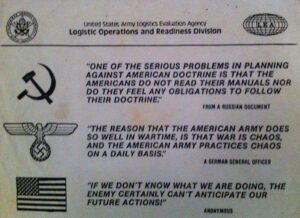Can’t Counter a Plan That Doesn’t Exist
 Understanding and utilizing the principles of solo RPG play can have enormous positive impacts on your face-to-face (digital or meatspace) team-oriented RPG experiences.
Understanding and utilizing the principles of solo RPG play can have enormous positive impacts on your face-to-face (digital or meatspace) team-oriented RPG experiences.
For one of the best examples that I have read on the subject, turn your browser to BDubs and Dragons. The man has a gift for writing afteraction reports that do more than provide a litany of “and then, and Then, and THEN”. Instead, he takes you through not just the events of each session, but what critical decisions he made as DM, how he analyzed each situation, and not just what his decisions were but WHY they were.
In his most recent post – go read Dubzaron Sessions 132, “Barsoom Bop” and come back – he provides a number of examples of how he used the solo gaming technique of “make up a mini-game and then play it” to neatly avoid making any big decisions. Instead, when the big campaign decision points came up, he offered a couple of possibilities, let his players throw their own ideas into the mix, and then let the dice decide the canonical results. Check this out:
It was at this point I used my memory of the John Carter series, some dumb space opera scifi concepts I made up on the spot, and taking suggestions from the PCs to come up with the following list of points of interest for us to roll on:1. Temple of Issus2. Burrow of the Ants3. Obelisk of the Chessman4. The Burnt Glass Plateau5. Tarzans House6. Abandoned Air-Shipyard7. Cold North8. Ornithopter TowerNow tell me you wouldn’t want to adventure in ALL those locations. If you say “well Dubs those sound boring I’d prefer to adventure in the Caves of Chaos for the 75th time” then perhaps you should consider another hobby.
This keeps the players engaged in a way no conventional DM advice does. They become not just passengers on the session train, but potential engineers. This kind of ‘polling by dice roll’ invites them to create the kinds of challenges they want to overcome. Even better, it encourages players to vocalize and commit to their desires in a way that goes beyond the typical GM advice seen throughout the hobby. It forces players to commit to suggestions with the very real threat that their suggestions might become reality. If you want players to invest into a campaign, this is how you get it. You offer them a payout for their investment.
o. You know the former has hangars and fuel tanks and offices and barracks and 90% noncom personnel while the latter is a subterranean maze full of dead ends and weird fungal farms and food stores and 90% mindless drone ants. Run with it. Let your players ask where the X is, then put your finger on the map and draw a route there that passes through danger. Use Appendix A or Appendix B to flesh out the blank spaces if you have to.
It’s not easy to DM in this style. You have to be able to roll with the changes and give up a lot of creative control. You have to be willing to whip up encounter maps on the fly. You have to trust yourself to understand how to create an ornithopter tower or an ant burrow as you g
Want to know what lies outside the Marvin city of Helium? Forget what Burroughs wrote, they aren’t playing on Burroughs’ Barsoom, but their own tabletop RPG Barsoom, and that means turning not to the books for answers, but to the dice:
I answered “which direction are the Marvins” by rolling a d8 for which direction on a compass. The answer was “East”. Then “how far away” I like the PCs roll on this fast chart I made while they talked about nonsense:“It is X Y where X is 2d6 and Y is (d6):
1-3. miles
4-5. hexes (which are 6 miles each)6. mega hex (which are 36 miles each)”Well they rolled like 7 mega hexes so the Marvins were actually 256 miles away (lol, lmao).
Anyway, read the full blogpost to see what BDubs rolled and how he rolled with it.
Because BDubs also provides a clinic on how to take an established IP, in this case Barsoom, and fold it into your own campaign in a way that opens up the creative space rather than shuts it down. He touches on how the words “Barsoom” and “Dejah Thoris” instantly convey a wealth of information, which is a good thing. Most RPG tables take the concept too far and try to nitpick the canon of the established IP. After flirting with that disastrous course, Dubzaron players veered hard into the concept of “this is OUR version of Barsoom, it only has to adhere to canon in the broadest of strokes”. The poindexters who make their personality memorizing every scrap of detail about a given IP balk at such heretical notions. Real Players take what they love and ignore the rest, letting the source material inspire – not handcuff – their games.
